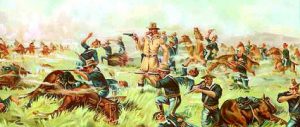The history of the forced removal of the Lakota Sioux from their lands, while it seems to have happened long ago, is vibrantly alive for the Indians living on the reservation today. Many of them can tell stories of how their parents were sent to faraway boarding schools and taught that their culture was inferior. The ban on Lakota culture and language was lifted only in 1971, well within the memory of many living adults.
The profound cultural trauma that these people have experienced has left many of them deeply hopeless and without a clear sense of their own future or destiny as a nation. Everywhere I went during a week I spent on the Pine Ridge Indian Reservation, I heard again the stories of the treaty of 1868, of the massacre at Wounded Knee, and of the theft of the sacred Black Hills which are held to be the origin of the Lakota people. I experienced the profound mistrust of outsiders, particularly white people. And I witnessed among some residents a sense of defeat far more profound than any I have observed in all my travels in less developed countries throughout the world.
On the reservation today, the only truly successful business is a gambling casino called Prairie Winds (Native Americans are exempt from state prohibitions on organised gambling). Unfortunately, but not surprisingly, many of those who lose money are themselves Native Americans. There is talk of developing wind power; so far these conversations have not led to substantial results. While there is also talk of oil and mineral resources, the Indians will not permit the sacred lands to be scarred with mines, and in a case of “environmental injustice”, new uranium mines off the reservation threaten to taint downstream Indian rivers with radioactive materials.
There are signs of hope, but these are few: two Native American brothers have been appointed to lead the Badlands National Park and Mount Rushmore. An image of the great Indian warrior Crazy Horse is being carved a few miles away from the images of the US presidents. A sacred Black Hills mountain, Bear Butte, is being closed to non-Indians during times when rituals are most important, although its peace is also gravely threatened by the opening of a nearby rifle range, and the bars, campgrounds, and concert venues have greatly offended the local tribes.
A college, the Oglala Lakota College, has been opened on the reservation, where it offers advanced degrees in Lakota studies, nursing, business, information science, social work and other relevant fields. A “Lakotafund” has been created to extend micro-credit to small businesses such as beadwork and other traditional handicrafts. Some who have left the reservation to pursue advanced degrees and learn skills in other parts of the country have returned to try to make a contribution back home.
Meanwhile, in Washington, DC, the National Museum of the American Indian, established in 1989 by an act of Congress in an effort to acknowledge the great wrong of our history, is managed by Native Americans, whose greatest desire is to convey the message that “we’re still here”. Whether the US president, Barack Obama, will encourage Congress to revisit the great question of ownership of the Black Hills, and whether there are symbolic measures that could be taken to help move the Sioux nation toward healing, remains to be seen.
What, then, are we to take as lessons from this horrific story, and what might be relevant for Chinese policy makers today? First, it is worth reflecting on the relationship between resources, land, nation-building, and power – and reflecting seriously on the question of how to build a strong, prosperous nation while safeguarding justice for all citizens. Sometimes rigorous introspection and honesty may be required to discover whether one is using cultural superiority and stereotyping as a way to rationalise the seizure of other people’s land. In this case, resource extraction was a primary motivation for seizing Indians’ land, but it was often cloaked in rhetoric about doing what was best for the Indians.
Second, good intentions can sometimes be highly destructive. The American missionaries and civilisers truly believed that in forbidding the use of Lakota language and the practice of Lakota customs they were doing the right thing – even, perhaps, saving the Indians’ “souls” and allowing them to find a place in heaven by converting them to Christianity. However, the deprivation of identity and pride has turned out to be devastating for the native people, who are now trying to recover some of their traditions by reviving rituals such as the Sun Dance and to re-learn their language in native-run schools.
Third, modern technologies such as the gun, the road and the railroad, and foreign diseases such as smallpox, were highly destructive to the native peoples, and created an “uneven playing field” such that the native peoples had little chance of preserving their way of life. As environmental historians such as Jared Diamond and Alfred Crosby teach us, the outcome of this sort of clash of cultures can be determined as much by technology, disease and introduced species as by more conventional measures of military superiority.
Fourth, one of the high prices of civilisation and resource extraction is often environmental degradation and ecosystem transformation. Instead of the buffalo, passenger pigeon and tall grass prairie, the central United States saw desertification and dust storms, especially in the 1920s, a heavy and enduring price to pay for our overly enthusiastic grazing and farming practices.
Finally, indigenous peoples’ knowledge, while often not expressed in ways that modern “science” can hear and respect, nonetheless often can point the way toward more sustainable relationships with the land. Although some have warned against romanticising Native American wisdom and called “the ecological Indian” a myth, it is undeniable that the Sioux elders predicted that in the wasteful and over-consuming way of the white man lay ecological disaster.
I hope that this cautionary tale of the Pine Ridge Sioux provides fruit for reflection and discussion. Although there are obviously great historical differences between the United States and China, we have much to learn from each other, especially at this time when the gaps in our economic and social development are decreasing and we are coming more and more to resemble each other.
Judith Shapiro is director of the Natural Resources and Sustainable Development MA Program at the School of International Service, American University, Washington DC.
Homepage image by Serge Van Cauwenbergh


